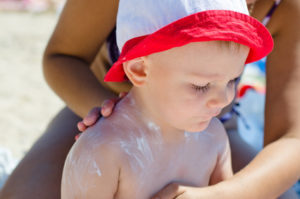As summer begins, it’s time to get out and enjoy the sunshine! However, sun exposure can be dangerous, and we all need to be diligent about proper protection. Unfortunately, a vast majority of both melanoma and non-melanoma skin cancers come from damage caused by the sun, but there are many ways to protect ourselves from these complications.
Sunscreen is a very important method to protect our skin from dangerous UV rays. Effective sunscreens, labeled as “broad spectrum” protect from both UVA and UVB rays. Sunscreens are categorized based on their SPF, which stands for Sun Protection Factor. These values range from 4 up to over 100, but the general consensus among experts is that an SPF sunscreen of 15-30 will do a sufficient job at protecting the skin from damaging UVB rays and that SPF higher than 50 doesn’t offer much additional benefit. However, there is no downside or potential harm to using a higher SPF sunscreen, so it’s fine to use if that is what’s in the cabinet.
It is especially important for parents and caregivers to protect children from excess sun exposure and sunburns, and to teach them proper sun safety. The American Academy of Pediatrics recommends that children less than six months of age be kept out of direct sun completely. However, sunscreen can be applied in small amounts to exposed areas of the skin, especially on the face. In children older than six months, sunscreen should be applied to all exposed areas of the body, 15 minutes before going out in the sun, and should be reapplied every two hours, or more frequently if they are swimming. Sunscreens containing zinc oxide are best for areas more susceptible to burning, including the cheeks, nose, and tops of ears.
In addition to sunscreen, protective, tight-weave clothes should be worn whenever possible when out in the sun. It is possible to overheat, however, so clothing should be lightweight and light colored. Hats with a brim are also advisable, to protect the top of the head, ears, and back of the neck. Remember, “baseball hats” don’t offer any protection to the tops of the ears or the back of the neck! Eyes are also sensitive to the UV rays from the sun, so sunglasses are recommended. Children should have properly fitting sunglasses as well.
It is also best to sit under cover, and not in direct sunlight, whenever possible. Trees provide great shade. The sun’s rays are strongest between 10am and 4 pm, so limiting time outside during these hours will lessen sun exposure as well. It is also important to remember that the UV rays from the sun penetrate through clouds, so it is still possible to get burned on overcast, cloudy days. If you’re going to be outside at all, it is best to protect yourself with sunscreen and clothing.
Make sure to stay hydrated as well – sweating and higher body temperatures lead to increased fluid loss, so it takes even more water to stay properly hydrated. Remember, you are with your skin every day, so if you notice a mole or rash that looks abnormal, be sure to bring it to your doctor’s attention immediately.
Enjoy the beautiful NH summer, but protect your skin from problems in the future by wearing (and re-applying) sunscreen, keeping your skin covered with tight-weaved clothing, staying in the shade, wearing sunglasses, and drinking water.
The Skin Cancer Foundation and healthychildren.org have excellent tips.
Contributor:


